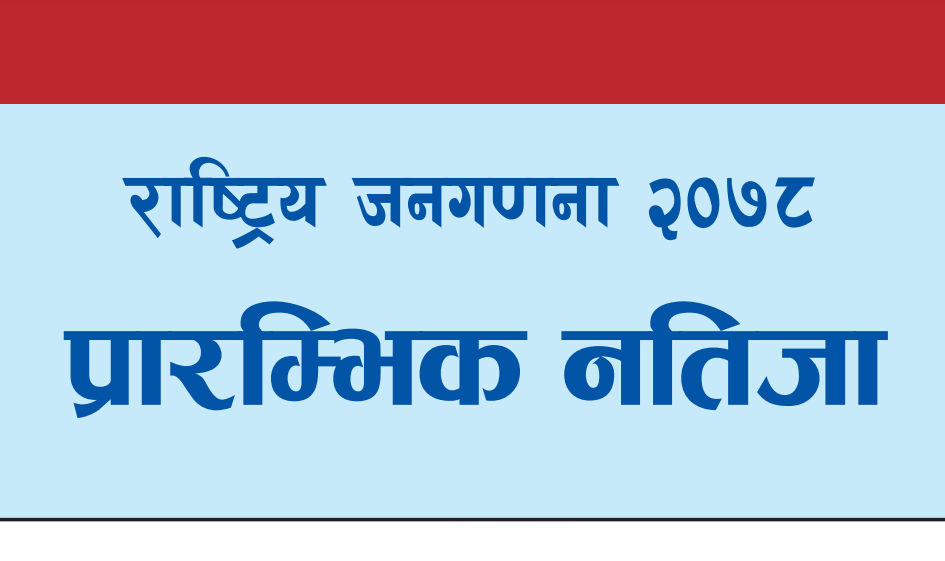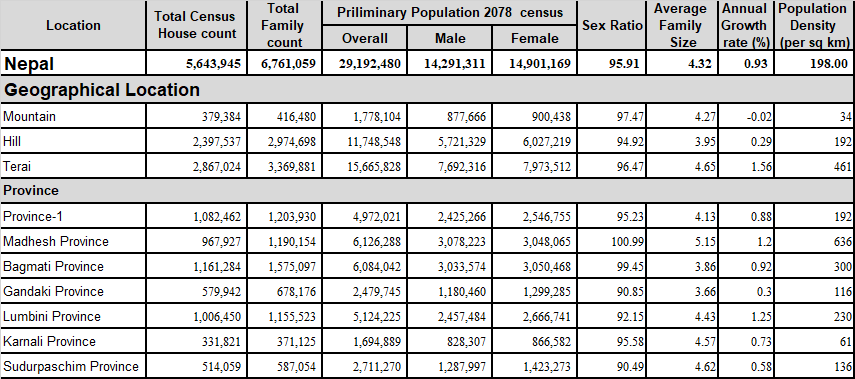Key highlights from the Preliminary Census Report 2021 (2078)
Overview
This preliminary Census report-2021 (2078 BS) consist of updated demographic data of Nepal which can be utilized by the central (federal), state (provincial), and local governments for decision making. The final report is still to be published.
Census takes place in Nepal every 10 years. The Census of 2021 (2078 BS) is the 12th census of Nepal which was started since 1991 AD (1968 BS). The National Population and Housing Census (NPHC) is part of an integrated national statistical system of Nepal.
According to the preliminary census report(2021), the population of Nepal has reached 2,91,92,480 accounting 1,42,91,311 ((48.93%) males and 1,49,01,169 (51.04%) females with the sex-ratio of 95.91 (census 2011: sex ratio= 94.16). The population has increased by 26,97,976 in 10 years. The average annual growth rate of past 10 years is 0.93% (census 2011: annual growth rate=1.35).
Census of house and families (Family count increased )
There are a total of 67,61,059 families residing in 56,43,945 houses. The family count is increased by 13,33,757 (24.57%) compared to last census of 2011.
Family Size (Family size has shrinked)
According to the preliminary census report(2021), the average family size of Nepal is 4.32 which was decreased from 4.88 from the census of 2011. In urban area, average family size is 4.25 (census 2011: average family size=4.27) whereas in rural area is 4.55(census 2011: average family size=5.02). The average family size was highest in Madhesh province (5.66) and lowest in Gandaki province (3.66). Similarly, Dolakha has lowest average family size (3.41) whereas higest average family size was found in Rauthat district(5.92).
Urban-rural population distribution (urban population has increased)
The urban population accounts to 66.08% whereas the rural population accounts to 33.92%. The urban population has increased by around 3.6% whereas the rural population has decreased by around 3.6% in compared to census 2011. People from rural area migrate to urban area in the search of infrastructures health facilities, jobs etc.
Nepalese residing abroad has increased
According to preliminary census report 2021, A total of 21,69,478 peoples ( Males: 17,63,315; Females: 4,06,163) are residing abroad. Nepalese living abroad has increased by 2,47, 984. The females residing abroad had increased by 71.09% compared to census of 2011. The top 5 districts from where maximum people had gone abroad and residing outside are Kathmandu, Kailali, Jhapa, Rupendehi and Morang. The top five district from where least people had gone abroad and staying outside are Manang, Dolpa, Humla, Mugu and Mustang.
Conclusion
Through the population has grown by 10.18% in ten years, the annual growth rate is lowest at 0.93% in the history of 80 years. The major possible reasons for decline in population growth are increased migration, decline in fertility rate and urbanization.





Post comment